Home Roasting Coffee
Using a Poppery Popcorn Popper
I guess the question is WHY would someone want to roast their own coffee? Some answers are it is cheaper in the long run, you have more control over what you drink but the overwhelming answer would be a truly better brew than anything you can get in a store.
If you are a regular coffee drinker, then home roasting will change they way you look at your coffee...guaranteed.
Let me give an analogy. Let’s say that you are planning a dinner. You decide steaks on the grill, baked potatoes and a salad. So you take off and head down to the local supermarket for supplies. As you fill your cart and check off things on your list, you come to the salad fixings; lettuce, carrots, red pepper and finally tomatoes. You see a large display of tomatoes; you know they're tomatoes because the sign says so, and with the prices being as high as they are, they obviously must be good, right? Well, you know the answer to that one.
However you know that the tomatoes on this salad will be from your garden...and they cannot compare to any store bought tomato.
That’s the analogy for home roasted coffee.
Coffee beans are a crop, no different than corn or potatoes or tomatoes. Most of all coffees are grown on farms of varying sizes, ranging from very large multi thousand acre ranches to small plots of and acre or two. It is a very labor intensive product.
Coffees also have different flavor characteristics. The beans from the Islands are different than the ones from Latin America. Likewise African beans are different than South American beans. That’s the
beauty of this hobby, you get to try them all.
What Should I Roast Today?

Coffee beans store very well. If you prep for food storage you'll like this part of the deal. Green beans store for about two years at room temperature. You can also vacuum seal them and deep freeze for longer
if you wish. Now once they are roasted, the shelf life is a matter of days, 7-10 at the most. That is one reason why it's almost impossible for store bought coffee to give you a truly fresh product. Once they are ground, the life is a matter of minutes. So you'll roast for a weeks supply, or less...and grind right before you brew.
Let’s look at the actual process. I'll share with you what I've learned and used for a while.
First of all I use a Poppery Popcorn popper. You can find them on EBay for between $50-$75, and much less at a thrift store if you can find one. The original Poppery is the best due to the fact that it has 1500 watts, full metal roasting cup and is modifiable* (I’ll explain this at the very end). You definitely want to avoid lesser wattage and any model that has a screen roasting cup.

You'll also need a couple large stainless steel mixing bowls, a metal colander, heavy duty power extension cord...like what you'd use for a hedge trimmer, oven mitt, a 1/2 cup measuring cup, glass storage container...like a ball jar or one that has the lid that clasps with spring like clip and you'll also need some beans.
There are numerous places to buy green beans. Three come to mind that I have done business with and recommend. I am in no way affiliated with these companies, just as a customer.
http://www.sweetmarias.com
http://www.coffeebeancorral.com
http://www.unclebeanz.com
Keep in mind shipping costs for your beans. Being on the East Coast I tend to use East coast companies as their shipping costs are lower than would be for me from the West Coast.
A great way to start with a broad selection is a sampler from Sweet Marias
http://www.sweetmarias.com/prod.gree...shtml#samplers
The set up is fairly simple. Make sure you have adequate ventilation, as the beans will give off some smoke during the roasting process. I use an outside stairwell as this gives me protection from the wind, kids and dog.
Don't Let This Smile Fool You....

1. Starting off I label the jar that I am going to store my beans in before hand.
2. Find an electrical outlet that has high wattage, like for a clothes washer. You don't want to start your roast and have the breaker pop if someone turns on another electrical appliance. Plug in your cord and run it out to where you are going to roast.
3. Measure out your beans. With the Poppery, use ½ cup increments. I typically use between 3 and 4 roasts. This gives me about ¾lb and you should measure out roasts in separate cups.
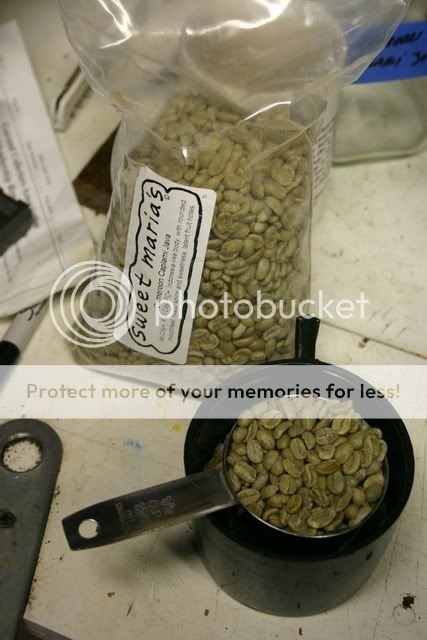
4. Set your Poppery up with a bowl beneath the spout of the Poppery. This bowl will catch the chaff that comes off the beans when they roast. Beans have a very thin membrane covering them, This is called chaff. As the beans roast they lose their moisture and gradually expand, the chaff will fly out of the Poppery.
5. Set the other steel bowl off to the side along with the steel colander. These two will be used to cool the beans down after roasting
6. Your roasting set up will look something like this;
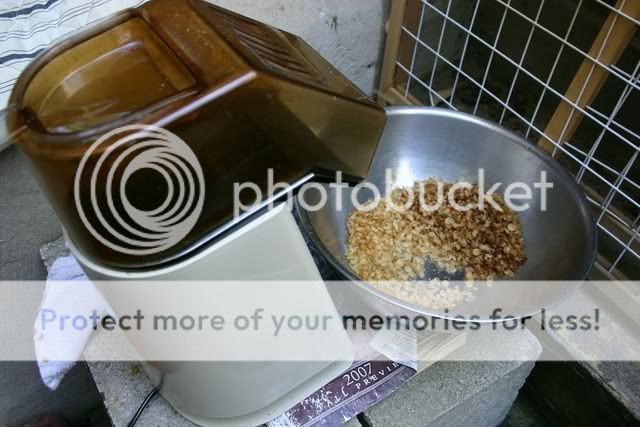
7. Dump ½ cup of beans into the Poppery and turn it on. Don’t plan on doing anything else while this is running. The difference between a great roast and charcoal is a matter of a minute. So stay on your game here.
So now that we have beans in the Poppery and the juice on, how do we tell what we have?
When you first turn on your Poppery, you’ll see the beans start to swirl around. The air will move them around and with the heat applied and you’ll smell them start to cook. The smell is like cooking bread or grass. The beans will go through a number of changes as they cook. First they’ll start turning from light green to a light tan. They are losing moisture at this point. Next the chaff will start coming off the beans. Now, some beans have a lot of chaff and some very little. Don’t worry about the volume or lack thereof with chaff. Next stage is the beans will go from a light tan to a light brown, and their size will increase. You will notice that the roasting cup is filling to about 2/3 full. The next stage is called “First Crack”.
Here is the same bean before and after roasting
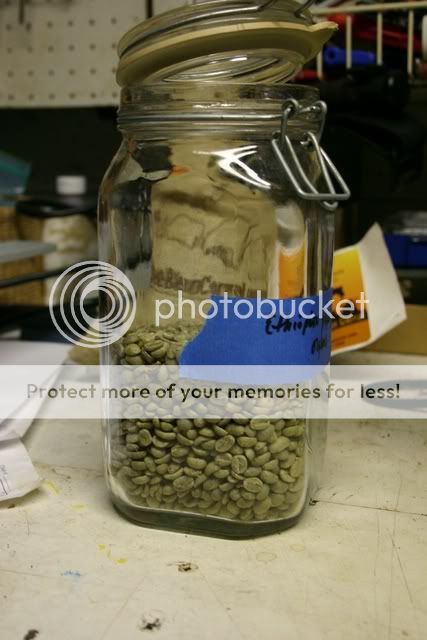
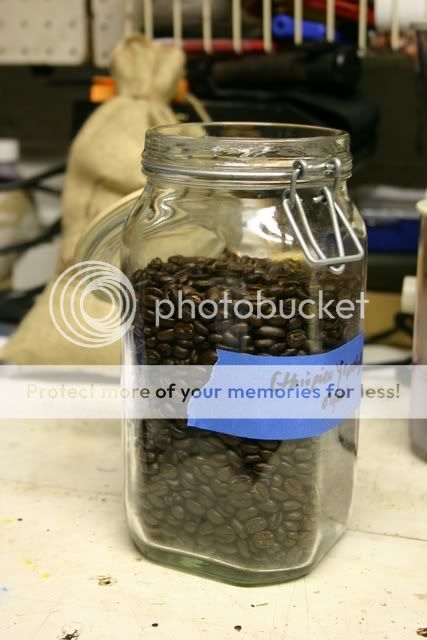
First Crack is where the bean has eliminated much of its moisture and the outer shell is cracking in the heat. This sounds like popcorn popping. It will be fairly loud and distinct. At this point the beans are at a stage called “City” or “City Roast” This is a light roast and for some beans this will give a fruity flavor.
Immediately following the First Crack will come a period of no popping sound, the beans will continue to darken. The next step in their evolution is called “Second Crack”.
Once the beans start the Second Crack, you are at “Full City” or Full City Roast. The beans are at a medium brown and getting darker by the second. Second Crack is also very distinctive as it sounds like “sizzling”. It will sound different than the First Crack. You’ll hear one or two sizzles and then they will build up tempo.
When I reach Second Crack, I count to Ten, using one thousand one…one thousand two etc, and immediately shut off the heat, remove the top, use your mitt here and dump into the steel bowl. You want to cool as quickly possible.

This gives me “Full City+” which is my ideal roast. This roast is not a French Roast. You’ll experiment with various roasts until you find out exactly what you like.
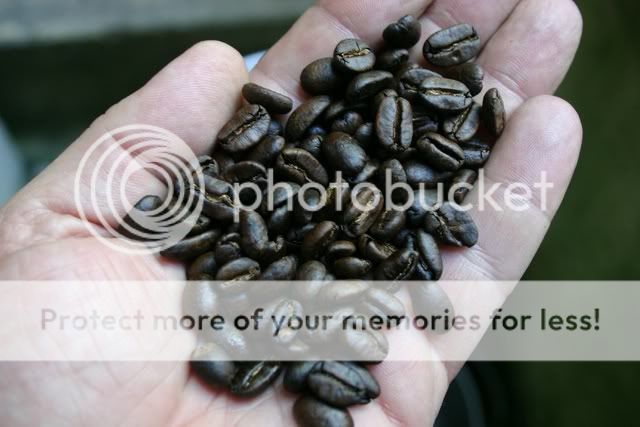
Now one thing I want to share with you. Roasting beans in this manner is an “audible” process and not a “visual” process. Once you reach Second Crack and your “count” you don’t have to see what you’re doing, just listen. I just roasted a perfect lb the other week in the dark with a flashlight.
Let’s talk about heat for a minute. I said at the top of this page about the Poppery being modifiable. Personally I feel this is a must, however when I first started I didn’t modify my Poppery. It took me about 3 complete roasts until I figured out that it was a better way.
Here’s why. When your roast is complete, the Poppery is still hot, very hot. Heat on the beans will continue to cook them. The modification allows for quick cooling. This only involves changing one wire from one post to another post. This makes the Popperys fan run as soon as it is turned on. The fan and not the heat. The heat is still applied by turning on the power switch.
So with the modification, you put the beans in, plug in the machine…it starts blowing the beans like before; when you are set, turn the power switch on, and now they cook as before. When you reach your chosen time at Second Crack, flip the power switch off…the beans will almost immediately stop cooking as the cracks will stop. Leave the beans in and let them continue to cool with the fan on for a minute or two, then dump out.
__________________
"Political correctness is a doctrine fostered by a delusional, illogical, liberal minority, and rabidly promoted by an unscrupulous mainstream media, which holds forth the proposition that it is entirely possible to pick up a turd by the clean end."
Using a Poppery Popcorn Popper
I guess the question is WHY would someone want to roast their own coffee? Some answers are it is cheaper in the long run, you have more control over what you drink but the overwhelming answer would be a truly better brew than anything you can get in a store.
If you are a regular coffee drinker, then home roasting will change they way you look at your coffee...guaranteed.
Let me give an analogy. Let’s say that you are planning a dinner. You decide steaks on the grill, baked potatoes and a salad. So you take off and head down to the local supermarket for supplies. As you fill your cart and check off things on your list, you come to the salad fixings; lettuce, carrots, red pepper and finally tomatoes. You see a large display of tomatoes; you know they're tomatoes because the sign says so, and with the prices being as high as they are, they obviously must be good, right? Well, you know the answer to that one.
However you know that the tomatoes on this salad will be from your garden...and they cannot compare to any store bought tomato.
That’s the analogy for home roasted coffee.
Coffee beans are a crop, no different than corn or potatoes or tomatoes. Most of all coffees are grown on farms of varying sizes, ranging from very large multi thousand acre ranches to small plots of and acre or two. It is a very labor intensive product.
Coffees also have different flavor characteristics. The beans from the Islands are different than the ones from Latin America. Likewise African beans are different than South American beans. That’s the
beauty of this hobby, you get to try them all.
What Should I Roast Today?

Coffee beans store very well. If you prep for food storage you'll like this part of the deal. Green beans store for about two years at room temperature. You can also vacuum seal them and deep freeze for longer
if you wish. Now once they are roasted, the shelf life is a matter of days, 7-10 at the most. That is one reason why it's almost impossible for store bought coffee to give you a truly fresh product. Once they are ground, the life is a matter of minutes. So you'll roast for a weeks supply, or less...and grind right before you brew.
Let’s look at the actual process. I'll share with you what I've learned and used for a while.
First of all I use a Poppery Popcorn popper. You can find them on EBay for between $50-$75, and much less at a thrift store if you can find one. The original Poppery is the best due to the fact that it has 1500 watts, full metal roasting cup and is modifiable* (I’ll explain this at the very end). You definitely want to avoid lesser wattage and any model that has a screen roasting cup.

You'll also need a couple large stainless steel mixing bowls, a metal colander, heavy duty power extension cord...like what you'd use for a hedge trimmer, oven mitt, a 1/2 cup measuring cup, glass storage container...like a ball jar or one that has the lid that clasps with spring like clip and you'll also need some beans.
There are numerous places to buy green beans. Three come to mind that I have done business with and recommend. I am in no way affiliated with these companies, just as a customer.
http://www.sweetmarias.com
http://www.coffeebeancorral.com
http://www.unclebeanz.com
Keep in mind shipping costs for your beans. Being on the East Coast I tend to use East coast companies as their shipping costs are lower than would be for me from the West Coast.
A great way to start with a broad selection is a sampler from Sweet Marias
http://www.sweetmarias.com/prod.gree...shtml#samplers
The set up is fairly simple. Make sure you have adequate ventilation, as the beans will give off some smoke during the roasting process. I use an outside stairwell as this gives me protection from the wind, kids and dog.
Don't Let This Smile Fool You....

1. Starting off I label the jar that I am going to store my beans in before hand.
2. Find an electrical outlet that has high wattage, like for a clothes washer. You don't want to start your roast and have the breaker pop if someone turns on another electrical appliance. Plug in your cord and run it out to where you are going to roast.
3. Measure out your beans. With the Poppery, use ½ cup increments. I typically use between 3 and 4 roasts. This gives me about ¾lb and you should measure out roasts in separate cups.

4. Set your Poppery up with a bowl beneath the spout of the Poppery. This bowl will catch the chaff that comes off the beans when they roast. Beans have a very thin membrane covering them, This is called chaff. As the beans roast they lose their moisture and gradually expand, the chaff will fly out of the Poppery.
5. Set the other steel bowl off to the side along with the steel colander. These two will be used to cool the beans down after roasting
6. Your roasting set up will look something like this;

7. Dump ½ cup of beans into the Poppery and turn it on. Don’t plan on doing anything else while this is running. The difference between a great roast and charcoal is a matter of a minute. So stay on your game here.
So now that we have beans in the Poppery and the juice on, how do we tell what we have?
When you first turn on your Poppery, you’ll see the beans start to swirl around. The air will move them around and with the heat applied and you’ll smell them start to cook. The smell is like cooking bread or grass. The beans will go through a number of changes as they cook. First they’ll start turning from light green to a light tan. They are losing moisture at this point. Next the chaff will start coming off the beans. Now, some beans have a lot of chaff and some very little. Don’t worry about the volume or lack thereof with chaff. Next stage is the beans will go from a light tan to a light brown, and their size will increase. You will notice that the roasting cup is filling to about 2/3 full. The next stage is called “First Crack”.
Here is the same bean before and after roasting


First Crack is where the bean has eliminated much of its moisture and the outer shell is cracking in the heat. This sounds like popcorn popping. It will be fairly loud and distinct. At this point the beans are at a stage called “City” or “City Roast” This is a light roast and for some beans this will give a fruity flavor.
Immediately following the First Crack will come a period of no popping sound, the beans will continue to darken. The next step in their evolution is called “Second Crack”.
Once the beans start the Second Crack, you are at “Full City” or Full City Roast. The beans are at a medium brown and getting darker by the second. Second Crack is also very distinctive as it sounds like “sizzling”. It will sound different than the First Crack. You’ll hear one or two sizzles and then they will build up tempo.
When I reach Second Crack, I count to Ten, using one thousand one…one thousand two etc, and immediately shut off the heat, remove the top, use your mitt here and dump into the steel bowl. You want to cool as quickly possible.

This gives me “Full City+” which is my ideal roast. This roast is not a French Roast. You’ll experiment with various roasts until you find out exactly what you like.

Now one thing I want to share with you. Roasting beans in this manner is an “audible” process and not a “visual” process. Once you reach Second Crack and your “count” you don’t have to see what you’re doing, just listen. I just roasted a perfect lb the other week in the dark with a flashlight.
Let’s talk about heat for a minute. I said at the top of this page about the Poppery being modifiable. Personally I feel this is a must, however when I first started I didn’t modify my Poppery. It took me about 3 complete roasts until I figured out that it was a better way.
Here’s why. When your roast is complete, the Poppery is still hot, very hot. Heat on the beans will continue to cook them. The modification allows for quick cooling. This only involves changing one wire from one post to another post. This makes the Popperys fan run as soon as it is turned on. The fan and not the heat. The heat is still applied by turning on the power switch.
So with the modification, you put the beans in, plug in the machine…it starts blowing the beans like before; when you are set, turn the power switch on, and now they cook as before. When you reach your chosen time at Second Crack, flip the power switch off…the beans will almost immediately stop cooking as the cracks will stop. Leave the beans in and let them continue to cool with the fan on for a minute or two, then dump out.
__________________
"Political correctness is a doctrine fostered by a delusional, illogical, liberal minority, and rabidly promoted by an unscrupulous mainstream media, which holds forth the proposition that it is entirely possible to pick up a turd by the clean end."
